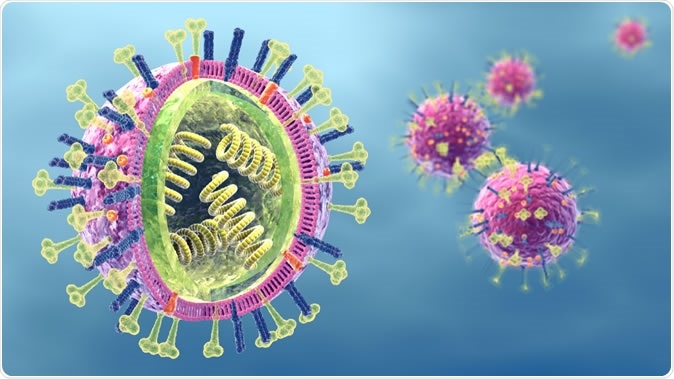Researchers from Skolkovo Institute of Science and Technology have found that the devious influenza virus is capable of new patterns of evolution and mutation in order to escape treatment with the currently available drugs and prevention with the currently available vaccines. This discovery however could help researchers predict the potential mutations in the genome of the virus and ultimately help them develop and design more effective vaccines against influenza.

3d illustration showing influenza viruses with RNA. Image Credit: Axel_Kock / Shutterstock
The study titled, “Allele-specific non-stationarity in evolution of influenza A virus surface proteins,” was published in the latest issue of PNAS.
Researchers explained that influenza viruses are notorious because of their capacity to mutate quickly. Unlike other viral diseases that can be prevented effectively by available vaccines, influenza shots need to be modified almost every year to overcome the mutation problem. The virus escapes the vaccine by altering its genome. The virus alters its genes by changing amino acid sequences and this changes their surface proteins. These surface proteins act as antigens which the body’s immune system recognizes from a previous infection.
When the antigens are altered, the immune system has to fight it off anew each time. The vaccines are also developed against these antigens. When the antigens are altered, the vaccines also need to be changed to adapt to this alteration. This makes influenza a menace each season with the immunocompromised population being most at risk of getting severely ill or succumbing to the infection. The immunocompromised population includes babies and elderly as well as the pregnant women and those with immunodeficiency diseases. Every year the new flu shot developed contains a mixture of surface proteins in order to fight off the fresh viral strains and boost the immune system.
This new study reveals that the mutations of the influenza virus are not random and could be predicted at least partially. As can be understood, this is a path breaking development in designing better vaccines that could fight off the influenza infections each season. The researchers explained that during the process of mutation and evolution, there is a process of natural selection where only the best and most virulent strain gets selected for survival. There are mutations that may be harmful to the virus itself. These mutations are often not selected. The team looked at the algorithms that could predict which mutations would be naturally selected by the virus to make itself more virulent.
The team from the Skoltech, the Central Research Institute of Epidemiology led by Skoltech Professor Georgii Bazykin, along with other colleagues, worked on the patterns of change of amino acids within the genome of the influenza virus that could alter the surface protein structure in a manner that could select the more virulent strain.
The team used bioinformatics and related methods to find that the time of origin of an amino acid was the determining factor in its chances of getting substituted. This pattern was called “senescence”. This was a process that dictated viral evolution, the team explained. This method of amino acid change led to the final change in the viral strain and its selection, they wrote.
Georgii Bazykin, lead author, explained, “The existing models are based on the assumption that the virus evolution is something like moving along a hilly plain, where the altitude above the sea level is the viral fitness, i.e., how effectively it can infect the host. We observe that the landscape is more like a stormy sea surface. The viral evolution resembles the movement of a surfer who has to stay on the top of the wave which escapes from beneath his feet and has to keep moving not to drown. The existing models try to predict the movements of the surfer, but it is difficult to do it without understanding that it is the wave that moves.”
Writing about the significance of their finding the authors of the study wrote, “we show that fitness conferred by an amino acid variant at surface proteins of influenza A virus changes systematically with time since this variant appeared. The direction of this change depends on its functional role. At antigenic regions, variants become less fit with time. Conversely, variants at internal regions become more fit with time.” They added, “This dynamic can be explained by a simple model: while the fitness of amino acids deeply embedded in the protein increases due to substitutions elsewhere, that of amino acids exposed to the immune system drops as herd immunity adapts to them.”
The authors of the study conclude, “…findings reveal a previously undescribed facet of adaptive evolution and suggest approaches for prediction of evolutionary dynamics of pathogens.”
Journal reference:
Allele-specific nonstationarity in evolution of influenza A virus surface proteins Anfisa V. Popova, Ksenia R. Safina, Vasily V. Ptushenko, Anastasia V. Stolyarova, Alexander V. Favorov, Alexey D. Neverov, and Georgii A. Bazykin PNAS first published October 2, 2019 https://www.pnas.org/content/early/2019/10/01/1904246116